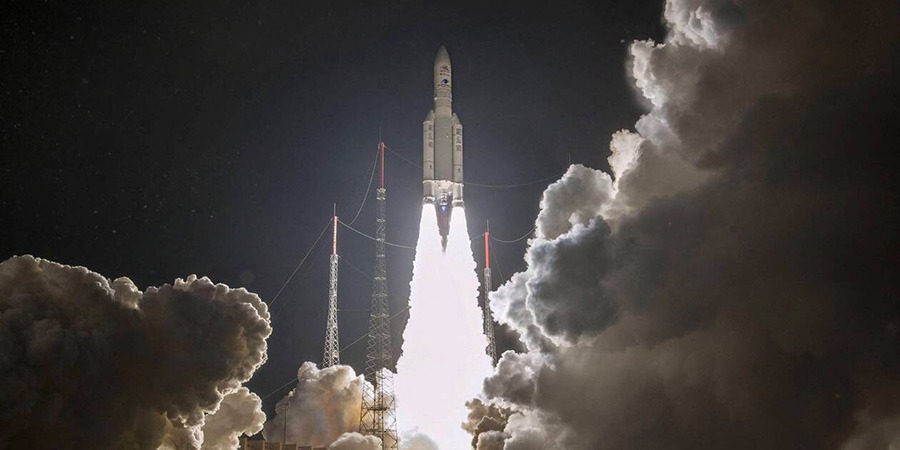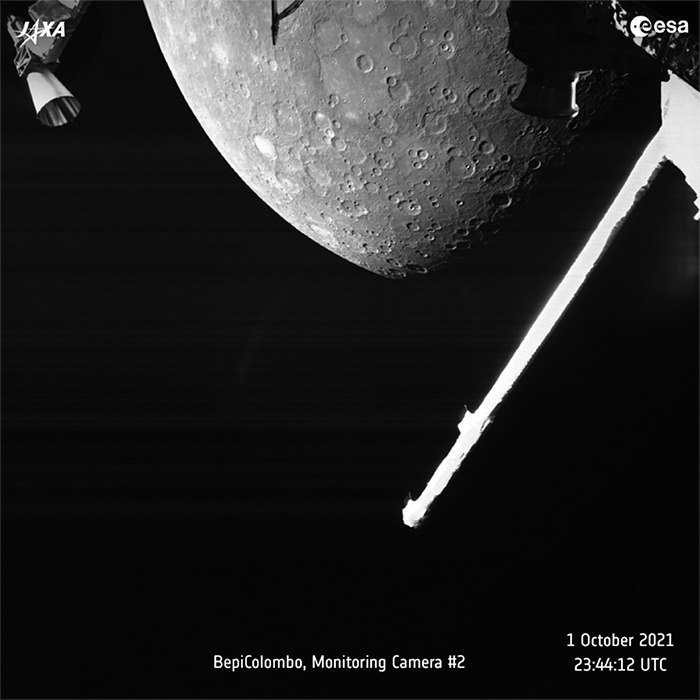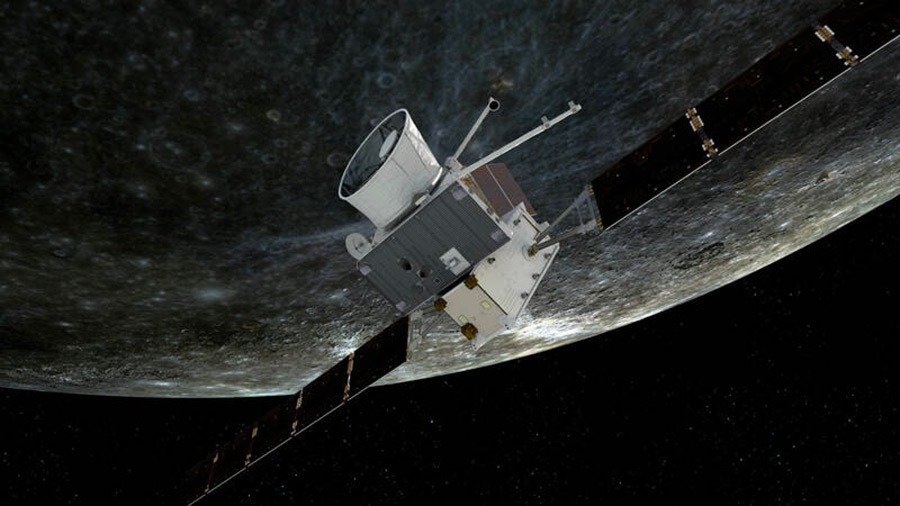RENDEZVOUS IM ALL: AKTUELLESTE NEUIGKEITEN RUND UM DIE VON ARIANE GESTARTETE BEPI-MISSION ZUM MERKUR
26.10.2021

Die am 19. Oktober 2018 von Ariane 5 gestartete BepiColombo-Sonde hat gerade eine entscheidende Phase ihrer Mission absolviert
Am 1. und 2. Oktober feierte man den Jahrestag des Starts der europäisch-japanischen (ESA und Jaxa) Mission von BepiColombo mit dem ersten Vorbeiflug am Merkur bereits etwas verfrüht. 2025 wird die Raumsonde in die Umlaufbahn des Planeten eindringen.

BepiColombos erster Blick auf Merkur ©ESA/Jaxa
Die Mission erweist sich aufgrund der erforderlichen Flugbahn als besonders komplex, kann jedoch erstmals unser schubstärkeres Vulcain-2-Triebwerk (+ 2,25 %) nutzen. Die Erhöhung wurde im Rahmen des Verfahrens zur Leistungsoptimierung der europäischen Trägerrakete beschlossen. Sie trägt ab jetzt den Namen Ariane ECA. Dank dieser Innovation kann BepiColombo mit sogenannter „Fluchtgeschwindigkeit“ in Richtung All katapultiert werden. Das ist jene Mindestgeschwindigkeit, die man braucht, um der Erdanziehung zu entkommen und die Sonden mit einer Reisegeschwindigkeit von rund 120.000 km/h auf eine Umlaufbahn um die Sonne zu befördern.
Der mit 100 Millionen Kilometern enorm lange Anflug hat vor drei Jahren begonnen, wobei die Ankunft im Zielorbit noch weitere vier Jahre in Anspruch nehmen wird. Rückblickend hat die Raumsonde nach ihrem erfolgreichen Start mit Ariane 5 in Kourou mit doppelter Unterstützung durch Erde und Venus ihren Weg Richtung Merkur eingeschlagen. Der nun einige Tage zurückliegende Vorbeiflug ist der erste von sechs gezielten „Swingby“-Manövern, bei denen man den Schleudereffekt nutzt, um BepiColombo einzubremsen, damit er später den Merkur umkreisen kann.

Die BepiColombo-Mission bei ihrem Start im Jahr 2018 ©ESA-CSG-CNES-AE-AG
Sowohl die Teams als auch die gesamte Raumfahrt-Community waren hocherfreut über den Vorbeiflug, bei dem die von ihren Anhängern kurz „Bepi“ genannte Raumsonde erste Aufnahmen und wissenschaftlich verwertbare Daten zu erfassen vermochte.

BepiColombo’s first view of Mercury ©ESA/Jaxa
The asteroid impact craters giving Mercury its moon-like appearance stand out particularly starkly in the light and shade of the planet, which also has the most craters of any planet in the Solar System. However, make no mistake, the history of this planet is probably very different from that of our natural satellite. The initial theory adopted by researchers is that Mercury used to be far larger and that a giant impact could have ejected most of its rock.

Artwork showing the first overflight of Mercury by the European-Japanese BepiColombo probe (©Image ATG medialab ESA)
Once it arrives, the mission will be able to study the planet from every angle (magnetic field, exosphere, surface), to gain a clearer understanding of the formation and life of a planet so close to its star (only 46 million kilometers away!). ArianeGroup is proud to have been able to launch such a productive mission, which will continue to excite us until 2028.

BepiColombo’s first view of Mercury ©ESA/Jaxa
Mercury does not have the equivalent of our Moon’s bright, ancient highlands: its surface is dark almost everywhere and was formed by vast outpourings of lava billions of years ago. These lava flows bear the scars of craters made by asteroids and comets crashing onto the surface at speeds of several tens of kilometers per second. The floors of some of the oldest and largest craters have been flooded by more recent lava flows and there are also more than a hundred sites where volcanic explosions have burst through the surface from below.
BepiColombo will explore these aspects to help us better understand this mysterious planet, using the data collected by NASA’s Messenger mission. It will address questions such as: Which volatile substances transform violently into gas to feed the volcanic explosions? How did Mercury retain these volatile substances if most of its rock has gone? How long did the volcanic activity last? At what rate does Mercury’s magnetic field change?
BepiColombo’s main scientific mission will begin in early 2026. It is using a total of nine planetary fly-bys: one of Earth, two of Venus and six of Mercury, plus its own solar electric propulsion system, to help it reach Mercury’s orbit. Its next overflight of Mercury will be on 23 June 2022.